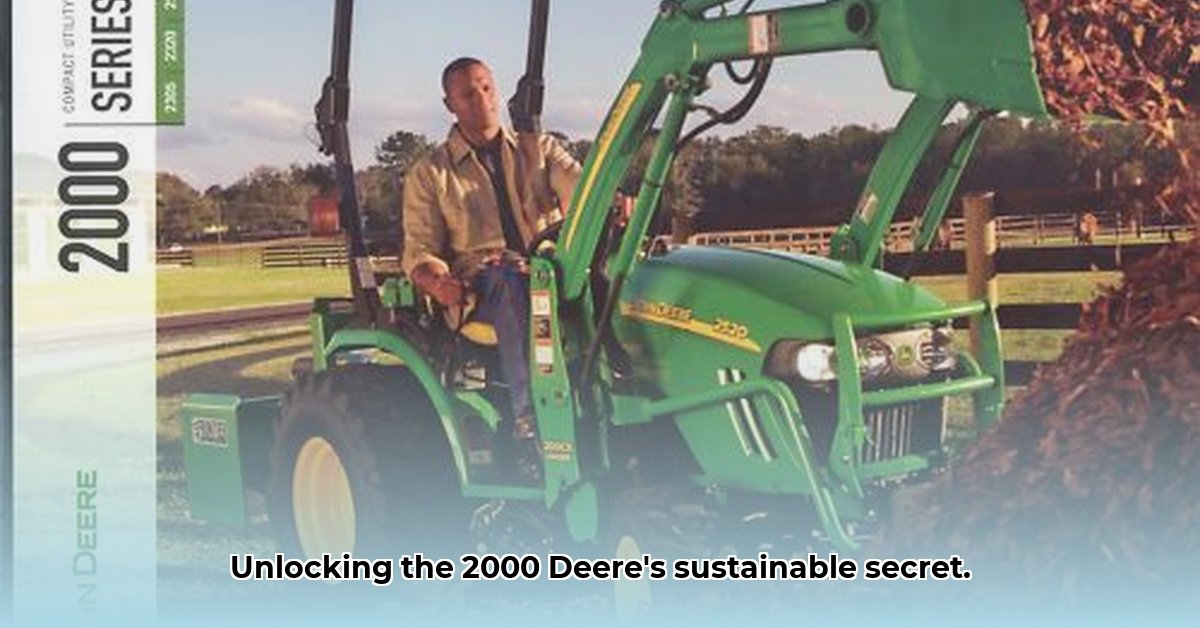
2000 John Deere Tractor: A Sustainable Farming Retrospective
The John Deere 2000, a tractor manufactured by Zetor for John Deere between 1993 and 1998, presents a compelling case study in the intersection of agricultural mechanization and sustainable practices. While not explicitly marketed for sustainability, its features and the era in which it operated offer valuable insights into the evolving relationship between technology and environmentally conscious farming. This deep dive analyzes its potential contribution to sustainable agriculture, acknowledging the limitations of currently accessible data. Was the John Deere 2000 a genuinely sustainable tool, considering the prevailing agricultural practices of the time? Or did it simply represent a transitional phase in the journey towards more environmentally friendly farming? For toy collectors, see these miniature models.
Specifications and Capabilities: A Workhorse of Its Time
The John Deere 2000, boasting a 45-horsepower engine and a 10-speed transmission, provided ample versatility for various farming tasks. Its 70-liter fuel tank minimized refueling interruptions, and its 3,568 kg rear lift capacity enabled the use of a wide range of implements. Built by Zetor, known for its cost-effective designs, the tractor likely offered relatively straightforward and affordable maintenance, a critical factor for sustainable farming. But how does this translate into actual on-the-ground sustainability? Did its fuel efficiency, for example, truly contribute to reduced environmental impact?
Data Challenges: The Need for Further Research
A significant hurdle in assessing the John Deere 2000's sustainability is the scarcity of readily available data. Specific fuel efficiency figures (liters per hectare), comprehensive lifespan data, and detailed analyses of its impact on soil compaction are largely unavailable. This lack of information hinders a conclusive assessment of its overall environmental footprint. While the engine specifications (2.7L 3-cylinder diesel) are known, a precise calculation of its greenhouse gas emissions remains elusive without additional data. This data deficit highlights the need for more comprehensive research into the long-term environmental impact of this—and similar—agricultural machinery.
Historical Context: A Time of Shifting Agricultural Paradigms
The John Deere 2000 emerged during a period of increasing environmental awareness within the agricultural sector. The seeds of precision agriculture—using technology to optimize resource utilization—were being sown. However, the question remains: Did the John Deere 2000 facilitate the adoption of these nascent sustainable practices? Did its use contribute to more efficient resource management, or was its impact less pronounced?
Pivotal Points:
- Data Scarcity: The limited availability of empirical data significantly hampers a definitive assessment of the John Deere 2000's environmental impact.
- Technological Context: Its introduction coincided with the early stages of precision agriculture, offering a unique lens into the technology's evolution.
- Cost-Effectiveness: Zetor's involvement suggests an emphasis on affordability, potentially making sustainable practices more accessible to farmers.
Unanswered Questions and Future Research Directions
To fully understand the John Deere 2000's role in sustainable agriculture, several crucial questions need to be answered:
- Fuel Efficiency: Precise fuel consumption data (liters/hectare) is needed to accurately assess its environmental impact compared to contemporary tractors. How did its fuel efficiency stack up against competitors?
- Lifespan and Maintenance: Data on the operational lifespan and maintenance requirements would shed light on its long-term economic and environmental sustainability. Was it a durable machine that minimized downtime and repair costs over its operational life?
- Soil Compaction: Analysis of its design and weight is necessary to understand its potential contribution to soil compaction, a significant factor in soil health. Did it lead to soil degradation over time?
- Integration with Precision Farming: An investigation into whether the John Deere 2000 was used in conjunction with precision farming techniques and its impact on this interaction should be considered.
To address these gaps, a multi-pronged approach is necessary:
- Data Collection from Owners: Surveys and interviews with past and present owners could offer invaluable insights into fuel consumption, maintenance, and overall lifespan.
- Comparative Studies: A comparative analysis of the John Deere 2000's performance against its contemporaries and successor models would provide valuable context.
- Preservation of Operational Units: Securing operational John Deere 2000 tractors for research purposes would facilitate hands-on studies.
Sustainable Agriculture: A Broader Perspective
The John Deere 2000 serves as a microcosm of the broader evolution of sustainable agricultural practices. While current data limitations prevent a definitive conclusion on its sustainability, its analysis offers insights into the enduring challenge of integrating technology with environmentally conscious farming. Further research is essential to fully comprehend its role—and the role of such machinery—in shaping a more sustainable agricultural future. The story of the John Deere 2000 remains incomplete, and future research will be crucial in completing this historical narrative.
Calculating Fuel Efficiency: A Practical Approach
The question of fuel efficiency remains central to assessing the John Deere 2000's sustainability. While specific data for this model is scarce, we can employ several methods to estimate its fuel consumption.
Estimating Fuel Consumption:
A basic approach involves multiplying the tractor's fuel consumption rate (gallons/hour or liters/hour) by the operational time (hours). However, this method fails to account for workload variations. A more sophisticated approach involves comparing available engine data to similar tractors tested by the Nebraska Tractor Test Laboratory (NTTL) 1, which provides horsepower-hours per gallon (hp-hr./gal.) data. This metric accounts for the intensity of the work performed, offering a more accurate estimate although data for the exact model might be limited.
Factors Affecting Fuel Efficiency:
Several factors influence a John Deere 2000's fuel consumption:
- Terrain: Uneven or hilly fields increase fuel consumption.
- Implement: Heavier implements demand more power.
- Maintenance: Proper maintenance ensures optimal engine performance.
- Operator Skill: Experienced operators can minimize fuel waste.
Improving Fuel Efficiency: Practical Tips
Even with older machinery, fuel efficiency can be improved:
- Regular Maintenance: Preventative maintenance is crucial.
- Tire Inflation: Proper inflation reduces rolling resistance.
- Gear Selection: Select appropriate gears to avoid engine lugging.
By considering these variables and implementing these practical tips, farmers can enhance the fuel efficiency of their John Deere 2000 and contribute to a more sustainable approach to farming.